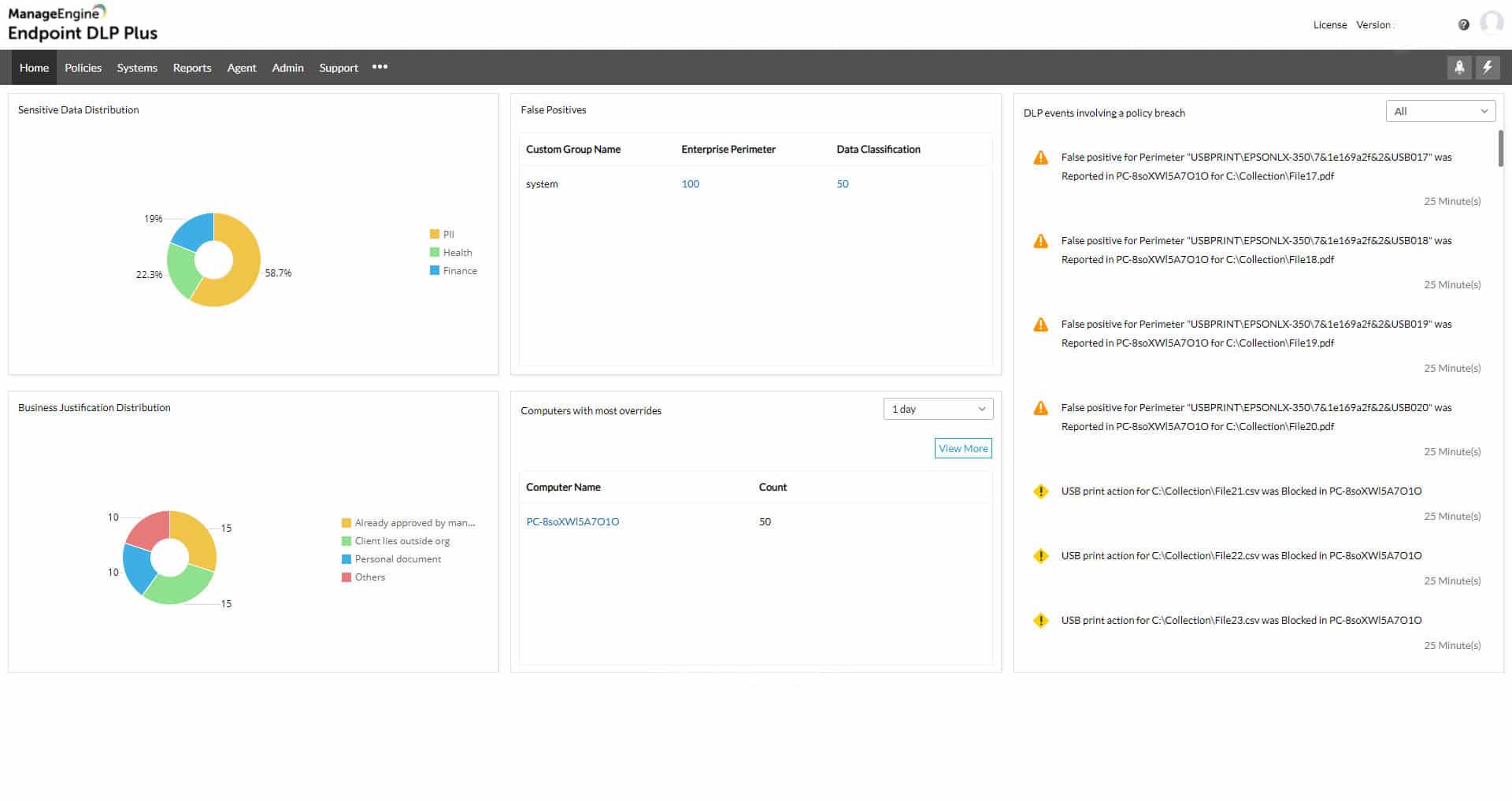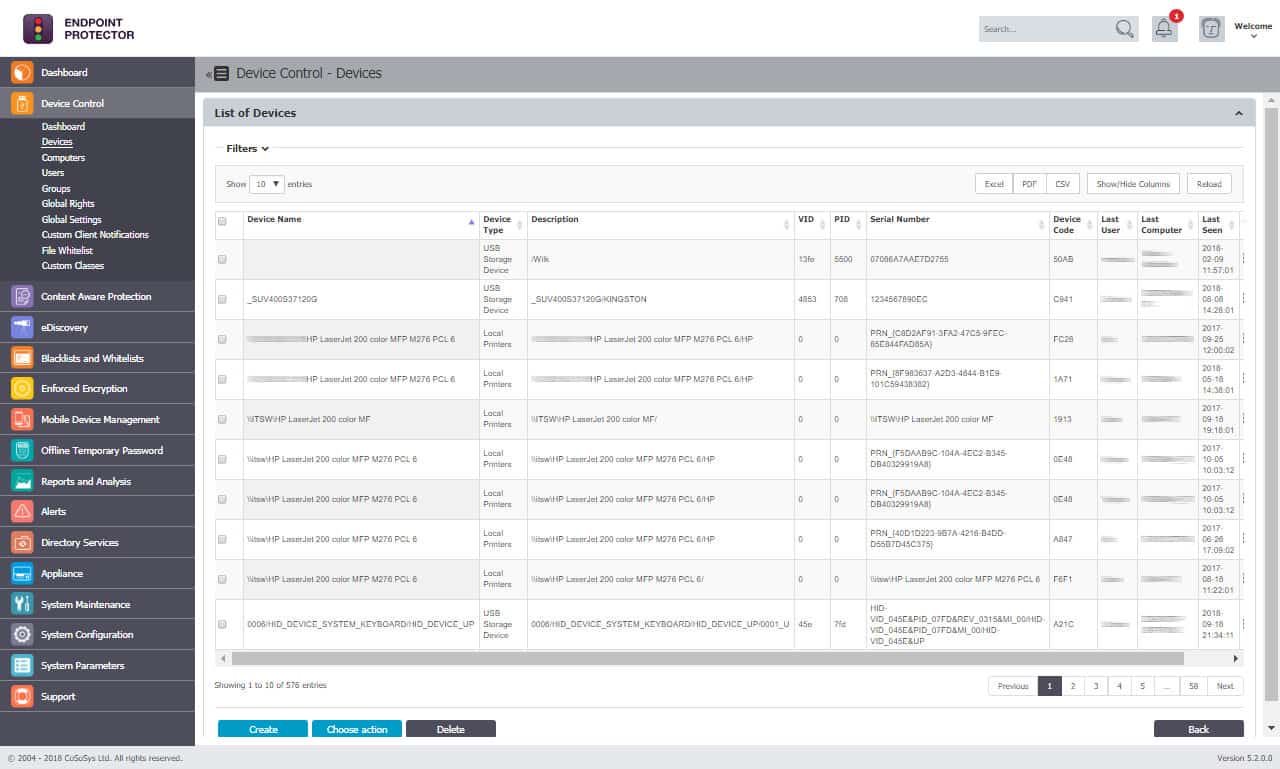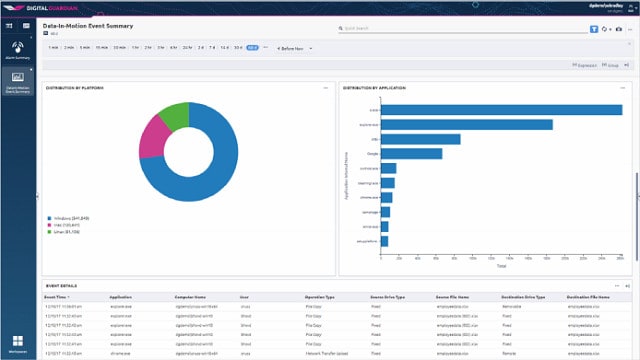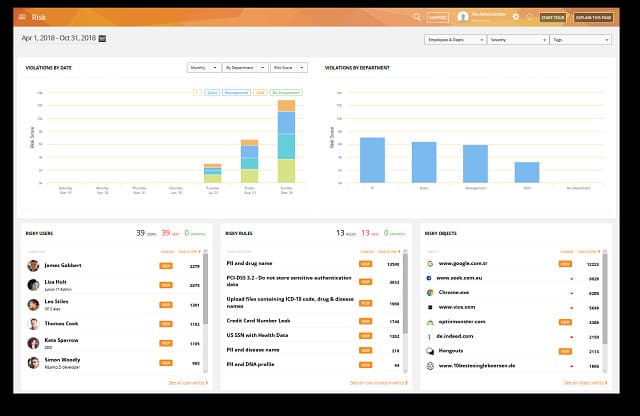Trellix Data Loss Prevention (Trellix DLP) is a relatively new product but it has much older roots. The Trellix brand was created in 2021 by a technology investment fund called Symphony Technology Group (STG). That fund bought MacAfee’s enterprise division and the cybersecurity company FireEye. The merger of these two purchases created Trellix. The Trellix DLP product came from McAfee Enterprise.
Trellix has five DLP products. These all have a common core but they are slanted to suit specific implementation strategies. These are:
- Trellix Data Loss Prevention Endpoint Complete
- Trellix Device Control
- Trellix Data Loss Prevention Discover
- Trellix Data Loss Prevention Network Monitor
- Trellix Data Loss Prevention Network Prevent
Some of these tools overlap, so you wouldn’t need to buy all of them – for example, Trellix Data Loss Prevention Endpoint Complete includes Trellix Device Control. The systems can apply data protection for cloud-based applications and data stores as well as on-premises systems.
In this review of Trellix DLP, we will explain each of these units individually, so that you can see which of them will suit your specific needs. The order in which we review these tools is irrelevant – we are not implying a hierarchy of importance here. We will start with Trellix Device Control because that is also included in the Data Loss Prevention Endpoint Complete, so knowing about the device control system will inform the purchasing decisions of those looking at the endpoint protection service.
Trellix Data Loss Prevention Discover
Trellix Data Loss Prevention Discover operates through endpoint agents to locate all data stores. It then examines each instance and field of data to assess its sensitivity. There is a built-in data classification system in the McAfee DLP solution. However, it requires a degree of manual involvement, which businesses with a lot of data to sift through might find burdensome. However, it is possible to associate an automated third-party classification system of your choice to take care of that problem.
The central dashboard controls all of the activities of the endpoint agents to interpret the security policies. In addition, you should set up before triggering the data discovery search. These policies can be organized to meet the requirements of data security standards.
Trellix defines its data management strategy in three steps:
- Inventory Locates data stores
- Categorization Identifies which data instances are high priority sensitive data
- Remediation Indexes and maps sensitive data instances
The Inventory step can search through files, databases, and cloud platforms. It can also scan through images of documents, pictures, screenshots, and forms, using OCR.
The Categorization service can identify related fields. These might not constitute PII in isolation but will represent a breach if released together. The Discover service conducts fingerprinting to identify these high-priority field combinations. Fingerprinting moves into the Remediation step, which produces a definitive landscape to which the security policies should be applied.
Trellix Data Loss Prevention Network Prevent
Trellix Data Loss Prevention Network Prevent applies the security policies over access controls you set up in the dashboard to the Discover module’s sensitive data. This system monitors all data movement utilities that are launched from endpoints, including email and messaging systems. The module also extends to the monitoring of data accessing applications that are resident on cloud servers.
DLP Prevent offers a range of remediation actions, including encryption, redirection, blocking, and quarantining. In addition, security policies can apply different actions to different sensitivity levels and user types.
Other Trellix Data Loss Prevention Network Prevent package facilities include performance and event analysis that can also examine logs of data breaches that occurred before the Trellix system was installed. Information gleaned from these studies can help you adjust your security policies, prove conformance with data security standards, or assess SLA goal achievement.
The prevent detection system integrates into all network-dependent channels of data movement: email, file transfers, and Web uploads. That is, all of the channels for file movements other than USB devices, which are covered by Trellix Device Control.
Trellix Device Control
Trellix Device Control protects endpoints by managing and controlling access to external devices – particularly USB memory sticks. This tool is part of Trellix’s broader DLP environment, so its functions are managed through the same console that you would use for the endpoint protection too. You don’t have to switch to a different interface to look at the Device Control function.
This system can block access to peripheral devices or optionally allow data movement but log it. The tool looks at USB drives, external hard drives, printers, and even Bluetooth devices. By establishing policies for which devices are allowed or denied, businesses can mitigate the risk of unauthorized data transfers, malware infections, or data leaks. For example, it can block users from transferring sensitive data to unauthorized USB drives or prevent malware-laden devices from accessing the network via endpoints.
Trellix Device Control also allows for detailed auditing and reporting of device activity, ensuring businesses have visibility into who is connecting what devices to their systems, and when. This feature is essential for detecting unusual or suspicious behavior, which can be flagged for investigation, thus enhancing the organization’s ability to respond swiftly to potential security incidents.
The solution provides granular control over devices based on a variety of parameters, such as device type, device ID, and user credentials. It also allows businesses to define different levels of access for different user groups, ensuring that device management policies align with role-based requirements. Integration with Trellix’s broader security ecosystem helps standardize management and makes it easier to enforce consistent policies across the network by protecting the ports of endpoints.
Trellix Data Loss Prevention Endpoint Complete
The endpoint unit of the Trellix DLP suite ties together the other units, such as the Discover and Prevent services. This is because the majority of the DLP solution is delivered from a SaaS platform in the cloud and Data Loss Prevention Endpoint Complete is the on-device unit the implements instructions and uploads data.
The unit is available for Windos and macOS, so businesses that run Linux computers will finds that the entire Trellix DLP platform unsuitable.
The endpoint system also offers a user awareness training module. Once again, this is delivered from the cloud through the endpoint service. All activities on each endpoint are uploaded to the cloud where the Trellix dashboard is hosted. This dashboard provides an overview of all activities across the enterprise with the option to drill down to information on a specific endpoint.
Trellix Data Loss Prevention Network Monitor
Trellix Data Loss Prevention Network Monitor provides live scanning of network traffic that adds extra security to the controls provided by Trellix Data Loss Prevention Complete. The behavior of this service is controlled by the security policies that you specify in the dashboard. In addition, this monitor contributes to the data pool used by the performance analysis service in the DLP.
The network monitor adds live activity scanning to the DLP strategy, which is similar to the philosophy of a SIEM – adding live network activity tracking to log file analysis. Data from the Trellix DLP can be forwarded to a SIEM for deeper threat analysis. However, the central aim of the DLP system is to deal with insider threats, accidental data disclosure, and data theft by intruders.
Trellix DLP deployment
The Trellix Data Loss Prevention suite is hosted on the cloud and subscribed to as a SaaS platform. The Data Loss Prevention Network Monitor unit will install a data collector on one of your endpoints. The Data Loss Prevention Endpoint Complete unit needs to be installed on premises. It is available for Windows and macOS.
Trellix DLP Pros and Cons
We examined the functionality of Trellix DLP and identified its strengths and weaknesses.
Pros:
- Performs an automated and continuous discovery and classification cycle
- Includes analytical functions that act as a SIEM
- Options to encrypt files to enforce security
- Unifies the monitoring of data on-site and in the Cloud
- Delivered as a physical or virtual appliance
Cons:
- No endpoint agent for Linux
Alternatives to Trellix DLP
The absence in DLP of endpoint agents for Linux is a big problem. If you have devices that run Linux, you can’t afford to just leave them out of your data protection program. Therefore, you will need to know about some alternative data loss prevention systems.
Our methodology for selecting a Trellix DLP alternative
We reviewed the market for data loss prevention systems and analyzed the options based on the following criteria:
- The ability to monitor devices running Windows, macOS, and Linux
- The option to combine monitoring for on-site and cloud resources
- Sensitive data discovery and classification service
- File integrity management
- Nice to have an integrated intrusion detection system
- A cost-free assessment opportunity in the form of a free trial or a demo system
- Value for money, represented by a fair price for the breadth of services offered
With these selection criteria, we have formulated a range of options.
Here is our list of the best alternatives to Trellix DLP:
- ManageEngine Endpoint DLP Plus EDITOR’S CHOICE This on-premises software for Windows Server provides protection for sensitive data with a discovery and classification service and file protection. The system also monitors user activity and controls the movement of protected data. Get a 30-day free trial.
- Endpoint Protector This system combines a cloud-based server with endpoint resident agents to provide constant protection that can continue online and an instantly updated threat protection system on the cloud.
- Digital Guardian DLP This data loss prevention platform monitors endpoints and networks to control and block data movements. This is a cloud-based system with endpoint agents for Windows, macOS, and Linux.
- Teramind DLP A cloud-based data loss prevention system that includes user and entity behavior analytics and insider threat assessments.
You can read more about each of these options in the following sections.
1. ManageEngine Endpoint DLP Plus (FREE TRIAL)
ManageEngine Endpoint DLP Plus can be tailored to support a specific data protection standard through the use of templates. The settings menu of the service includes a library of templates and each accounts for a set of data protection requirements. The system can be tailored to implement PCI DSS, HIPAA, GDPR, and many other data privacy specifications.
Key Features:
- Quick Security Policy Setup: Select from a library of templates
- Containerization of Files: Adds an extra layer of access authentication
- Data Movement Controls: Looks at email, cloud upload, and peripheral devices
- Compliance Reporting: GDPR, PCI DSS, and HIPAA
- On-Premises System: Runs on Windows Server
Why do we recommend it?
ManageEngine Endpoint DLP Plus includes a data discovery and categorization service that can be tailored to data protection standards, including GDPR, PCI DSS, and HIPAA. This system then protects those locations by containerizing the files that hold the data. An administrator defines authorized applications that are able to access the files.
The data discovery process in Endpoint DLP Plus searches through all of your endpoints for instances of the protected data types. These are then classified for importance and the files that contain those sensitive data instances are then protected.
File protection is implemented through containerization. This blocks all access attempts directly to file contents. Instead, access is granted to authorized, trusted software packages – you set up a list of these in the console for Endpoint DLP Plus. It should be assumed that only applications that themselves require credentials for use should be designated as trusted. This mechanism means that you consolidate your access rights management to combine both software and data.
Within the access granted to those trusted applications is a logging mechanism, so each access attempt is recorded and attributed to a specific user account. Suspicious access events can trigger further scrutiny of that particular user account. This is an insider threat monitoring system that also looks for account takeover.
Endpoint DLP Plus controls data movements, it doesn’t block them. This is an important feature because you don’t want the work of authorized users to be slowed down or prevented. Instead, certain users are allowed to perform certain actions. This can be narrowed down to specific file movement utilities on specific categories of data that are held in a specific location. So, a user might be able to copy one file but not another. It might be allowed to upload a file to a cloud platform but not to attach it to an email, while another user might be allowed to email a different file.
Data movement controls are implemented over email systems, cloud upload mechanisms, and attached devices, such as USB sticks. It is also possible to prevent data from being printed out.
Who is it recommended for?
This system implements granular controls that allow some users to access specific data stores through approved applications. The service includes activity logging for compliance auditing. This is an on-premises package that runs on Windows Server and there is a Free edition that will manage data on 25 endpoints.
Pros:
- Automated Data Management: Sensitive data discovery and classification
- Granular Controls: Rules that combine user authorization with data sensitivity levels
- Data Access Controls: Files locked with access allowed to trusted applications
- Automated Activity Monitoring: Includes a system of alerts
- Free Edition: Watches up to 25 endpoints
Cons:
- Focused on Endpoints: Doesn’t provide network scanning
Endpoint DLP Plus runs on Windows Server. A Free edition is available for small businesses to monitor up to 25 computers. The paid edition, called Professional is available for a 30-day free trial.
EDITOR'S CHOICE
ManageEngine Endpoint DLP Plus is our top pick for a Trellix DLP alternative because it uses a library of templates to quickly apply all of the regulations stipulated in specific data protection standards. The tool uses your existing access rights management system for applications by attaching access to sensitive data stores to specific software packages. The service also applies granular data movement controls to email systems, cloud upload mechanisms, printers, and USB sticks. This is a good package for enforcing the controls laid down in PCI DSS and HIPAA, GDPR, and other data protection standards.
Download: Get a 30-day free trial
Official Site: https://www.manageengine.com/endpoint-dlp/download.html
OS: Windows Server
2. Endpoint Protector
Endpoint Protector has endpoint agents for Windows, macOS, and Linux, coordinated from a cloud-based server. In addition, the controller includes a dashboard where you set up your security policies for supervision through the DLP service.
Key Features:
- Data Management: Sensitive data discovery and classification service
- Insider Threat Detection: Looks for anomalous behavior
- Scans Multiple Operating Systems: Windows, macOS, and Linux
- Device Controls: Approves USB sticks by serial number
Why do we recommend it?
Endpoint Protector is an allowlisting system that blocks all software from running. This prevents malware from running and it also stops employees from installing their own insecure utilities on company computers. An administrator sets up an access rights manager that combines data targets and applications with user permissions.
The endpoint agents offer all data protection functionality, so they continue to operate effectively even when the device is disconnected from the network. The cloud service gathers event data from endpoint agents and searches for combined threats. This is a lot like a SIEM configuration.
When beginning operations, you have to enroll devices in the program. However, those devices do not all need to be on the same network, and it is also possible to include cloud resources in the monitoring service.
On starting service, the server will scan and assess your access rights management system, producing suggestions of changes that can be made to tighten security. After installing endpoint agents, the server sends out instructions to starts a sensitive data discovery sweep. The types of data that the endpoint agents look for are modified according to the security policies that you create.
The discovery scan identifies all data and then classifies those instances to work out sensitive data that needs to be protected. The discoverer will then grade the sensitivity of each piece of data and apply the level of protection that is specified in the security policies.
Steps that can be taken to enforce security include the encryption of files to regulate access. The DLP also controls data movement onto printers and removable storage and through emails and file transfers.
The endpoint agents implement user and entity behavior analytics (UEBA). This profiles each user’s behavior and the activity of system processes. With this intelligence, the DLP can establish a baseline of regular activity. Deviations from this standard raise an alert.
Endpoint Protector is a great pick as an alternative to Trellix Data Loss Prevention because it has endpoint agents for Windows, macOS, and Linux. There is also a mobile operating system version, and the service can include the supervision of all platforms plus cloud resources in a unified security monitoring system. In addition, this data protection system includes controls over data exfiltration channels and performs UEBA to identify threats.
Who is it recommended for?
This package is suitable for any business and it will particularly appeal to companies that have no cybersecurity experts on the payroll. You don’t need any special knowledge to run this system. Its procedures are similar to account management processes that are familiar to any system administrator.
Pros:
- Data Access Controls: Allows specified users to access a particular type of data
- Control of Exfiltration Channels: Emails, cloud uploads, chat apps, printers, and USB sticks
- Threat Hunting: Focuses on insider threats
- Unifies Cloud and Site Security Monitoring: Protects data stores
Cons:
- Not Offered as an Appliance: SaS, cloud installation of virtual appliance
There are several deployment options for the server of Endpoint Protector. It is offered as a hosted SaaS platform, and it can also be accessed in the Marketplace of AWS, GCP, and Azure. The code can also be run on-site over a VM. Experience Endpoint Protector for free by accessing a demo.
3. Digital Guardian DLP
Digital Guardian DLP runs from a cloud platform through on-device agents. It can monitor activities on any device anywhere, unify multi-site and home-based devices into one monitoring service, and include cloud resources. In addition, each device agent operates independently, ensuring continuity of protection if the endpoint gets disconnected from the network.
Key Features:
- SaaS Platform: A managed service option is also available
- Data Exfiltration Controls: Scans network traffic for data movements
- Endpoint Agents: Available for Windows, macOS, and Linux
Why do we recommend it?
Fortra Digital Guardian DLP is an endpoint agent coordinator. This includes a data discovery and classification service but you can also choose to use a third-party tool for that task. The tool relies on external threat detection systems. It feeds activity data into a SIEM and then returns remediation instructions back to those agents for implementation.
The service is controlled from the cloud server, and all actions are performed on endpoints. Administration tasks, such as creating security policies, are performed through the system dashboard, which is accessed through any standard Web browser. In addition, the device agents upload activity reports for endpoints and networks, and these get processed into threat detection and activity reports on the server.
The server will reorganize your access rights management system and kick off a system scan run by the device agents. That sweep discovers all sensitive data locations and categorizes personally identifiable information (PII) and intellectual property. These data locations are then subjected to access monitoring.
Who is it recommended for?
This package is recommended for businesses that already have a suitable security package in operation and also have a sensitive data and discovery package. The Fortra system extends those third-party tools for endpoint monitoring. The system is available as a SaaS platform and as a managed security service.
Pros:
- Cloud-Based Hub: Offers threat detection as well as data protection
- Operates Through Endpoint Agents: Can unify the security monitoring of data on any device anywhere
- Applies Security Policies: Operates through an improved access rights management structure
Cons:
- Doesn’t Include Data Discovery or Classification: Relies on third-party tools for a data catalog
This service combines threat detection with data loss prevention. The device agents run on Windows, macOS, and Linux. They control USB ports, printers, emails, and file transfer systems. You check out Digital Guardian DLP with a demo account.
4. Teramind DLP
Teramind DLP is a SaaS platform with onsite modules for monitoring and remediation. This system is offered in versions for the health care industry and the financial sector and a general DLP service. In addition, it provides security policy templates for GDPR, HIPAA, ISO 27001, and PCI DSS.
Key Features:
- Insider Threat Detection: Scans use activity
- Remote User Monitoring: Accounts for lax data security in employees’ homes
- Fraud Prevention: Looks for unusual data access
Why do we recommend it?
Teramind DLP is part of a user tracking system and there are lower plans that only provide that service. The DLP edition adds on sensitive data discovery and classification. When tied into the user tracking system, that data identification system for a data loss prevention package.
The endpoint agents scan devices for data locations and then categorize all data instances to focus on sensitive data. Those data instances of interest then get graded further into bands of severity. This discovery service is continuous. The data discoverer will search through files, databases, and cloud storage, and it can find data in pictures and images of documents through the use of OCR.
Teramind DLP performs a risk assessment and an analysis of data access events to help you fine-tune your security policies. The system is able to identify anomalous behavior that could indicate insider threats, account takeover, or intrusion.
Who is it recommended for?
This system focuses on data misuse as well as data protection. That is, it allows users to get access to data but only for the use intended by the business and understood by the data subject. This system provides compliance management for GDPR, HIPAA, ISO 27001, and PCI DSS.
Pros:
- Sensitive Data Protection: Implements threat detection and data loss prevention
- System Hardening: Assesses the system to reduce risks
- Preset Controls for Specific Data Privacy Standards: GDPR, HIPAA, ISO 27001, and PCI DSS
Cons:
- No On-Premises Option: This is a SaaS package
Teramind DLP is available for a 14-day free trial.








